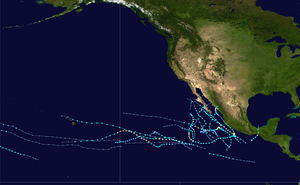Hurricane Barbara (2013)
Hurricane Barbara was the easternmost landfalling Pacific hurricane on record. As the first hurricane of the 2013 Pacific hurricane season, Barbara developed from a low-pressure area while located southeast of Mexico on May 28.[nb 1] It headed slowly north-northeastward and strengthened into a tropical storm early on the following day. After recurving to the northeast, Barbara intensified into a Category 1 hurricane on May 29 and made landfall in Chiapas at peak intensity with winds of 80 mph (130 km/h) and a barometric pressure estimated at 983 mbar (hPa; 29.03 inHg). When the hurricane made landfall, it was the second earliest landfalling hurricane in the basin since reliable records began in 1966. Barbara then moved across the Isthmus of Tehuantepec and dissipated within the mountainous terrain of Sierra Madre de Chiapas on May 30.
| Category 1 hurricane (SSHWS/NWS) | |
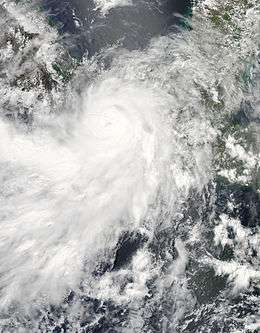 Hurricane Barbara at peak intensity on May 29 | |
| Formed | May 28, 2013 |
|---|---|
| Dissipated | May 31, 2013 |
| (Remnant low after May 30) | |
| Highest winds | 1-minute sustained: 80 mph (130 km/h) |
| Lowest pressure | 983 mbar (hPa); 29.03 inHg |
| Fatalities | 4 direct, 1 indirect |
| Damage | $358 million (2013 USD) |
| Areas affected | El Salvador, Guatemala, Southwestern Mexico, Eastern Mexico |
| Part of the 2013 Pacific hurricane season | |
The precursor of Hurricane Barbara brought light to moderate rainfall to El Salvador. Many homes were damaged, roads were flooded, and several trees were downed. One fatality was reported in the country. Landslides caused by rainfall in Guatemala forced 30 people to flee their homes. In Mexico, tropical cyclone warnings and watches were issued in anticipitation of the storm. Many shelters opened in Chiapas, Oaxaca and Guatemala while schools and ports were temporarily closed during the storm. Torrential rains and power outages were reported in the area. In the state of Chiapas alone, 2,000 houses were damaged. About 57,000 people were left homeless. Significant impact to agriculture was also reported, with 10,000 ha (25,000 acres) of crops destroyed. Overall, Barbara caused 5 fatalities and at least $358 million (2013 USD) in damage.
Meteorological history
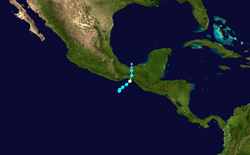
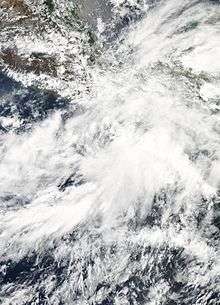
A tropical wave moved off the west coast of Africa on May 16 and crossed Central America into the Pacific Ocean on May 24.[1] That day, the National Hurricane Center (NHC) began monitoring an area of disturbed weather about 150 mi (240 km) southwest of the Costa Rican coastline.[2] At that time, this system was associated with a monsoon trough embedded within the Intertropical Convergence Zone.[3] Despite being disorganized, gradual development of this system was anticipated by the NHC.[2] On May 25, a broad low pressure area formed southwest of Nicaragua, after the tropical wave interacted with an eastward-moving Kelvin wave.[1] Convection soon became organized around the newly formed low, and the NHC noted that the formation of a tropical cyclone within the subsequent 48 hours was likely.[4][5] The NHC estimated that Tropical Depression Two-E developed at 1200 UTC on May 28 about 125 mi (205 km) south-southeast of Puerto Ángel, Oaxaca.[1]
With warm water temperatures of over 86 °F (30 °C) and low wind shear, the newly formed tropical depression was able to quickly intensify.[1] It developed a well-defined center with concentrated deep convection.[6] Continued organization prompted the NHC to upgrade the depression to Tropical Storm Barbara at 0000 UTC on May 29.[7] Post-analysis indicated that Barbara intensified into a tropical storm six hours earlier than originally assessed.[1] Barbara began exhibiting an eye-like feature, and intensity estimates using the Dvorak Technique reached 40 mph (65 km/h).[8] At this time, Barbara had begun to recurve to the northeast, within a gap of the subtropical ridge.[8] By midnight, the eye-like feature developed into a central dense overcast (CDO), embedded within the deep convection.[9] The rainbands of Barbara wrapped around much of the circulation, and radar imagery indicated the eyewall was consistently becoming better defined.[9] Thereafter, the storm entered a phase of intensification as it began to accelerate towards the Chiapan coastline.[10]
Barbara strengthened into a hurricane around 1800 UTC on May 29 while located about 65 mi (105 km) east-southeast of Salina Cruz, Mexico.[11] At its peak intensity as it was making landfall, it had maximum sustained winds of 80 mph (130 km/h) and a barometric pressure estimated at 983 mbar (hPa; 29.03 inHg).[11] With this intensity, Barbara made landfall on the coast of Tonalá, Chiapas at approximately 1950 UTC.[12] This marked both the easternmost and second earliest landfalling hurricane in the basin since reliable records began in 1966.[13] As Barbara moved inland within the Isthmus of Tehuantepec, rapid dissipation occurred.[14] The cloud tops warmed and Barbara degenerated into a tropical storm at 0000 UTC on May 30.[14][15] This was followed by a downgrade to tropical depression nine hours later as Barbara's low-level circulation was disrupted by the mountainous terrain.[16] Very early on May 31, the surface circulation of Barbara soon dissipated about 25 mi (40 km) north-northwest of Coatzacoalcos, Mexico, prior to emerging into the Gulf of Mexico.[17][1] The storm's associated leftover moisture partially contributed to the formation of Tropical Storm Andrea in the Atlantic.
Preparations
Immediately after developing into a tropical cyclone on May 28, a tropical storm warning was issued by the Servicio Meteorológico Nacional along the coast of southern Mexico spanning from Lagunas de Chacahua National Park in Oaxaca to Boca de Pijijiapan, Chiapas. When the storm threatened to become a hurricane, a hurricane warning was declared for this region at 1025 UTC on May 29.[1] In Campeche, a blue (minimal) alert was issued.[18] In Guatemala, a "preventive" alert was issued; Barbara was similar to Hurricane Mitch and Tropical Storm Agatha (both which devastated the nation) and thus had the potential to produce flash floods.[19] A yellow alert (moderate risk) was declared for central and southern Oaxaca and western Chiapas.[20] For the southeastern and eastern part of Oaxaca and southwestern and central-western Chiapas, a red (high risk) alert was issued.[21]
Many shelters were opened adjacent to rivers.[22] In Chiapas, 122 shelters opened, having a grand capacity of 300,000 people[23] though only 147 people used these shelters. In these shelters, officials set up 57 health centers.[24] In Oaxaca, shelters were set up in 20 towns and hamlets.[25] In all, coastal residents and marine interests were advised to take extreme caution in the states of Chiapas, Oaxaca, and Guerrero.[26] In addition, classes were suspended in Oaxaca.[21] Both large and small boats were anchored in Playa Manzanillo, to prevent being sunk by strong winds and rough seas, and water sports were suspended in Acapulco.[27] Ports in Chiapas were also closed because of the storm.[28]
Impact and aftermath
Central America
The precursor disturbance brought light to moderate rainfall to El Salvador. Many homes were damaged, roads were flooded, and several trees were downed.[29] A 44-year-old woman died when a tree fell on her. Strong winds and high waves damaged four homes in Barrio Playa, in the municipality of Acajutla. As a result, shelters were opened, though only seven people sought refuge in them.[30] This same disturbance brought landslides to Guatemala; consequently, 30 people moved to shelters.[31]
Mexico
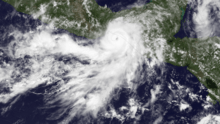
Starting early on May 29, the outer rainbands of Tropical Storm Barbara brought torrential rains to several states and power outages to Oaxaca, Chiapas, Guerrero, and Veracruz.[32][33] Rainfall in the country peaked at 19 in (470 mm).[34] In Ocosingo, 10 in (220.5 mm) fell in a 24‑hour period.[23] Upon making landfall, Barbara struck a largely undeveloped stretch of coastal lagoons, containing small fishing villages.[25] In Acapulco, however, torrential rains caused severe flooding on roads leading to resorts, while damaging some highways. In all, considerable damage was reported.[21]
Four people were killed in Oaxaca. A 61-year-old American drowned offshore from rough seas. A 26-year-old man died from drowning after attempting to cross a river. The third death was a 60-year-old man in Salina Cruz.[28][35][36][37] Furthermore, 14 fishermen went missing off the coast of Tapanatepec[28][38] two of which were quickly found alive.[36] Within a few days following Barbara, eight of the remaining missing had been found alive.[39] Of the four fishermen still unaccounted for, one was presumed to have died.[35] The towns of Tonala and Arriaga were the worst affected by the hurricane, where dozens of trees, poles, billboards and roofs were damaged due to strong winds. Many restaurants were also destroyed because of high waves. Several homes were flooded. Many homes were destroyed, leaving many homeless.[40] Throughout the rest of Chiapas, however, damage was minor.[41] Statewide, 50 people were evacuated and 2,000 homes were damaged.[42] Throughout the region, 57,000 people were homeless and 10,000 ha (25,000 acres) of crops were destroyed.[43] Approximately 3,500 ha (8,600 acres) of mango crops, accounting for a total yield of 22,751.88 t (50,159,300 lb) of mangoes,[44] were destroyed, with losses estimated at 4.53 billion pesos (US$358 million).[45]
Following the storm, which affected 19,000 people, 16 medical centers were opened, containing a combined 127 doctors and 318 nurses to provide medical care to devastated municipalities.[46] A state of emergency was declared for 36 municipalities in Chiapas[47] and for 5 municipalities in Oaxaca.[48]
See also
Notes
- All dates are based on Coordinated Universal Time (UTC).
References
- Daniel P. Brown (August 6, 2013). Hurricane Barbara Tropical Cyclone Report (PDF) (Report). National Hurricane Center. Retrieved August 16, 2013.
- Daniel P. Brown (May 24, 2013). Tropical Weather Outlook (Report). National Hurricane Center. Retrieved August 21, 2013.
- Jorge Aguirre-Echevarria (May 24, 2013). Tropical Weather Discussion (Report). National Hurricane Center. Retrieved August 21, 2013.
- John P. Cangialosi (May 26, 2013). Tropical Weather Outlook (Report). National Hurricane Center. Retrieved August 21, 2013.
- John P. Cangialosi; Michael J. Brennan (May 27, 2013). Tropical Weather Outlook (Report). National Hurricane Center. Retrieved August 21, 2013.
- John P. Cangialosi; Richard J. Pasch (May 28, 2013). Tropical Depression Two-E Discussion Number 1 (Report). National Hurricane Center. Retrieved August 21, 2013.
- Robbie J. Berg; Jack L. Beven (May 29, 2013). Tropical Storm Barbara Intermediate Advisory Number 1A (Report). National Hurricane Center. Retrieved August 21, 2013.
- Robbie J. Berg; Jack L. Beven (May 29, 2013). Tropical Storm Barbara Discussion Number 2 (Report). National Hurricane Center. Retrieved August 21, 2013.
- Todd B. Kimberlain; Daniel P. Brown (May 29, 2013). Tropical Storm Barbara Discussion Number 3 (Report). National Hurricane Center. Retrieved August 21, 2013.
- Richard J. Pasch; Christopher W. Landsea (May 29, 2013). Tropical Storm Barbara Discussion Number 5 (Report). National Hurricane Center. Retrieved August 21, 2013.
- Richard J. Pasch; Christopher W. Landsea (May 29, 2013). Hurricane Barbara Intermediate Public Advisory Number 5A (Report). National Hurricane Center. Retrieved August 21, 2013.
- Richard J. Pasch; Robbie J. Berg (May 29, 2013). Hurricane Barbara Tropical Cyclone Update (Report). National Hurricane Center. Retrieved August 21, 2013.
- Richard J. Pasch (May 29, 2013). Hurricane Barbara Discussion Number 6 (Report). National Hurricane Center. Retrieved August 21, 2013.
- Robbie J. Berg; Jack L. Beven (May 30, 2013). Hurricane Barbara Discussion Number 7 (Report). National Hurricane Center. Retrieved August 21, 2013.
- Robbie J. Berg; Jack L. Beven (May 30, 2013). Tropical Storm Barbara Public Advisory Number 6A (Report). National Hurricane Center. Retrieved August 21, 2013.
- Michael J. Brennan (May 30, 2013). Hurricane Barbara Discussion Number 8 (Report). National Hurricane Center. Retrieved August 21, 2013.
- Richard J. Pasch (May 30, 2013). Remnants of Barbara Public Advisory Number 10 (Report). National Hurricane Center. Retrieved August 21, 2013.
- "Emiten alerta azul en Campeche por tormenta Bárbara". El Universal (in Spanish). May 28, 2013. Retrieved May 29, 2013.
- "Guatemala en alerta preventiva por tormenta tropical "Bárbara" en el Pacífico". El Mundo (in Spanish). May 29, 2013. Archived from the original on October 12, 2013. Retrieved May 29, 2013.
- "Activan alerta en cinco estados por Bárbara". El Universal (in Spanish). May 29, 2013. Retrieved May 29, 2013.
- "Bárbara se acerca a costas mexicanas ya como huracán". El Universal (in Spanish). May 29, 2013. Retrieved May 29, 2013.
- "Alertan por intensas lluvias en Oaxaca". El Universal (in Spanish). May 28, 2013. Retrieved May 29, 2013.
- Oscar Gutierrez (May 28, 2013). "Chiapas, en alerta preventiva por posible ciclón". El Universal (in Spanish). Retrieved May 29, 2013.
- "Chiapas se prepara para enfrentar a Bárbara". El Universal (in Spanish). May 29, 2013. Retrieved May 29, 2013.
- "Hurricane Barbara landfall in Mexico 2nd earliest". Yahoo News. Associated Press. May 29, 2013. Retrieved May 30, 2013.
- "Alertan por ciclón frente a costas de Oaxaca". El Universal (in Spanish). May 28, 2013. Retrieved May 29, 2013.
- "Acapulco coloca bandera roja y cierran puertos por Bárbara". El Universal (in Spanish). May 29, 2013. Retrieved May 29, 2013.
- "Hurricane Barbara slams into Mexico's Pacific Coast; two dead". Los Angeles Times. May 29, 2013. Retrieved May 30, 2013.
- Liseth Alues (May 27, 2013). "Lluvias persisten en el país por sistema de baja presión". El Salvador.com (in Spanish). Archived from the original on June 10, 2015. Retrieved May 29, 2013.
- "Dejan lluvias en el Salvador un muerto y varias viviendas afectadas". Rotavio (in Spanish). May 27, 2013. Archived from the original on December 15, 2014. Retrieved May 29, 2013.
- "Se forma la tormenta Barbara en el Pacífico". Press Libre (in Spanish). May 28, 2013. Archived from the original on December 15, 2014. Retrieved May 29, 2013.
- "Afectará a cinco estados la tormenta tropical Bárbara". El Universal (in Spanish). May 29, 2013. Retrieved May 29, 2013.
- Notimex (May 29, 2013). "Tropical Storm Barbara would increase to hurricane". The Financial (in Spanish). Archived from the original on October 12, 2013. Retrieved May 29, 2013.
- Georgina Saldierna (June 22, 2013). "Pérdidas por $250 mil millones por sequías e inundaciones en la última década: Peña Nieto". La Jordana (in Spanish). Retrieved June 24, 2013.
- Disaster List. Université Catholique de Louvain (Report). EM-DAT: The OFDA/CRED International Disaster Database. Archived from the original on February 3, 2014. Retrieved October 16, 2013.
- "Hurricane Barbara death toll rises to three in Mexico". The Voice of Russia: American edition. May 29, 2013. Archived from the original on August 5, 2014. Retrieved May 30, 2013.
- Alberto López Morales (May 29, 2013). "Oleaje de huracán Bárbara deja un muerto en Oaxaca". El Universal (in Spanish). Retrieved May 29, 2013.
- Jose Cortes (May 29, 2013). "Hurricane Barbara floods Mexico's southern Pacific coast, kills two". Ruters. Retrieved May 30, 2013.
- "Declaran emergencia al sur de México por daños de huracán Bárbara". El Universo (in Spanish). May 31, 2013. Retrieved June 2, 2013.
- "Tonalá y Arriaga, los más afectados por Bárbara". El Universal (in Spanish). May 30, 2013. Retrieved May 30, 2013.
- "Daños menores en Chiapas tras paso de 'Bárbara'". El Universal (in Spanish). May 30, 2013. Retrieved May 30, 2013.
- Lopez Morals (May 30, 2013). "Hallan a salvo a pescadores dados por perdidos en Oaxaca". El Universal (in Spanish). Retrieved May 30, 2013.
- "Bárbara dejó más de 57 mil damnificados". El Universal (in Spanish). June 5, 2013. Retrieved June 6, 2013.
- Octavio Vélez Ascencio (June 16, 2013). "Quiebra Bárbara cultivos de mango". Noticias Net (in Spanish). Retrieved June 24, 2013.
- Yuridia Torres (August 20, 2014). "Aseguradoras pagan 3 mmdp por huracanes y tormentas tropicales en 2013". El Financiero (in Spanish). Retrieved September 5, 2014.
- "Bárbara deja 19 mil damnificados: Velasco". El Universal (in Spanish). May 31, 2013. Retrieved June 2, 2013.
- "Declaran en emergencia 32 municipios de Chiapas". El Universal (in Spanish). June 1, 2013. Retrieved June 1, 2013.
- "Declaran emergencia en cinco municipios de Oaxaca". El Universal (in Spanish). May 31, 2013. Retrieved June 1, 2013.
External links
| Wikimedia Commons has media related to Hurricane Barbara (2013). |
